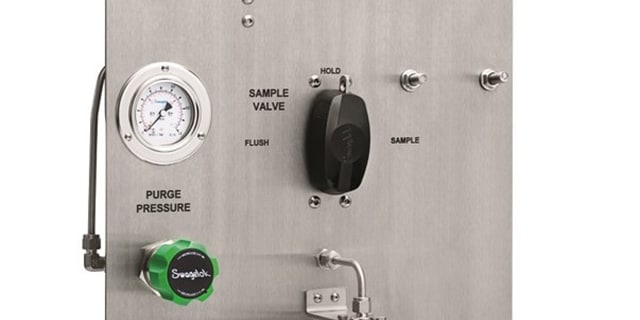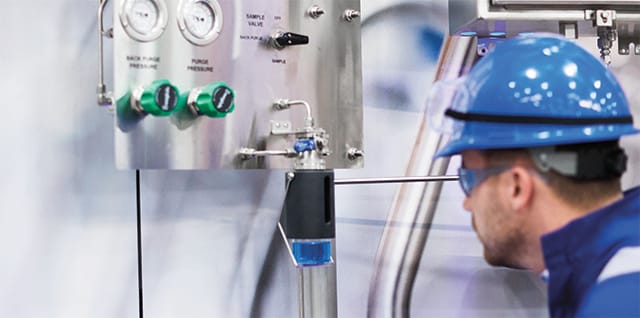Liquid Sampling Strategies to Control Costs

Controlling Costs and Reducing Errors in Liquid Grab Sampling
Grab sampling plays a critical role in accurate, profitable industrial processes. The practice can help validate process conditions, ensure end products are up to specification, and provide the information necessary to evaluate environmental emissions. However, grab sampling—also called spot sampling, laboratory sampling, field sampling, or closed-loop sampling—can be complex and challenging to execute correctly. Even small errors can negatively impact sample representativeness and production, driving up operating costs.
It is important that individual operators and technicians are equipped with the right skills to perform grab sampling correctly. There are several operational strategies that can help promote consistent, accurate, and cost-effective sampling at every location. Read on to discover three key methods to optimize liquid sampling in your plant.
 Use Sample Bottles Wherever Appropriate.
Use Sample Bottles Wherever Appropriate.
Choosing between sample cylinders or bottles is one of the first decisions to be made for liquid grab sampling and is largely dictated by the type of sample being collected.
Sample volatility and toxicity may necessitate the use of sample cylinders. Metal cylinders can help maintain precise pressure and temperature levels that may be required to keep a volatile liquid from fractionating or otherwise misrepresenting true process conditions. Cylinders are required in gas sampling systems, and are highly effective at protecting technicians and the environment from potentially toxic fumes or emissions.
However, sampling cylinders are significantly more expensive than glass or polyethylene chemical sample bottles, which can be effective for collecting nonvolatile, nontoxic liquids. Generally, these are large-molecule liquids with high boiling points that do not flow or ignite easily, ranging from bitumen used in roads and roofing to diesel fuels.
Basic Rules for Sampling
Grab sampling helps validate process conditions and ensure a quality end product. Keep these rules in mind for your grab sampling process:
- The sample must represent the process. Use probes to draw samples from the middle of the process pipe, and avoid phase changes during sample transportation.
- The sample must be timely. Minimizing transport time from the draw point to the laboratory helps ensure process conditions are accurately represented.
- The sample must be pure. Avoid dead legs upstream of the sample container, and allow for adequate purging and flushing of the sampling system to minimize the potential for contamination.
If your application allows for bottle collection, using them instead of cylinders can be an effective way to optimize grab sampling costs. Some bottle options include a self-sealing septum cap which can help prevent accident spillage or overfilling. Bottles also provide the opportunity for immediate visual analysis, helping technicians provide quick feedback on the sample stream.
Liquid sampling and gas sampling have some fundamental differences. This article is focused on liquid sampling. See our separate article on gas grab sampling best practices for more sampling strategies.
Maintain a Standard Sampling Process.
More extensive industrial fluid systems may require multiple sampling points. If this is required, it can be helpful to maintain consistent grab sampling processes and panels at each point to reduce the likelihood of error.
Consistency at multiple sampling points grants plant operators greater assurance that proper procedures are being followed at every point. Additionally, it offers convenience for the technicians drawing samples—consistency means they will not have to follow a different set of considerations or operations at unique points throughout the system. This can be helpful especially for technicians with varying skill levels and can make training easier.
To achieve this consistency, system engineers can specify a certain type of grab sampling panel in their designs. Beyond the scope of just one plant, global organizations can achieve grab sampling consistency by specifying a certain panel or certain liquid sampling equipment across all sites. This helps ensure that differing regional preferences will not influence the sampling process, and that sound procedures are being followed throughout the organization’s global footprint.
Choose Well-Designed Sampling Panels.
Advancements in grab sampling systems have helped make the process simpler, safer, and more repeatable. For plants that have been following the same grab sampling process for years, it is worth considering improvements that could be made to drive greater sampling efficiency and accuracy.

Elsewhere, some new sampling panels have been designed with heightened user convenience in mind. Obtaining samples, venting, flushing, and purging are all accomplished by operating a series of different valves. Today, geared valve assemblies are available that are designed to activate the necessary valves in the proper sequence, helping the operator more easily control fluid routing through the panel. Additionally, technicians can more easily isolate gauges when performing maintenance. Geared valve assemblies also help minimize the chance of operator error by preventing valves from being activated out of sequence. valves from being activated out of sequence.
Grab sampling is a critical process for chemical and petrochemical refining, oil and gas production, and a variety of other process-driven industries, and specifying modern grab sampling panels throughout a facility or facilities is one way to help control costs and minimize errors. Additionally, working with a supplier who can help identify your system’s unique needs can lead to additional benefits.
Interested in learning more about how to optimize your grab sampling processes? Explore our solutions for grab sampling, and contact our team to discover how our team can help.
Related Articles

Grab Sampling 101: Reducing Plant Costs
Grab sample systems allow for safe, efficient sample captures—validating your product’s chemical composition. Learn how to improve your closed loop system’s reliability while reducing plant costs with basics from the experts at Swagelok.

Avoiding Classic Liquid and Gas Sampling System Mistakes
Whether you’re working with a gas or a liquid sample, common sampling system mistakes often occur during initial design. Learn how to avoid classic sampling mistakes and get better gas and liquid samples every time with design tips from Swagelok.

How to Fix Common Grab Sampling Deficiencies
There are several common fluid systems that successful plant operation depends on and outsourcing their fabrication can be highly beneficial if you are short on resources.

